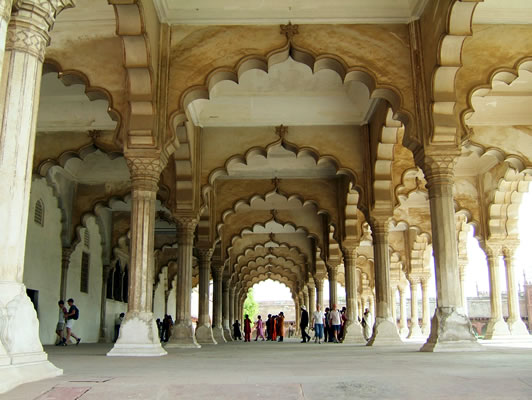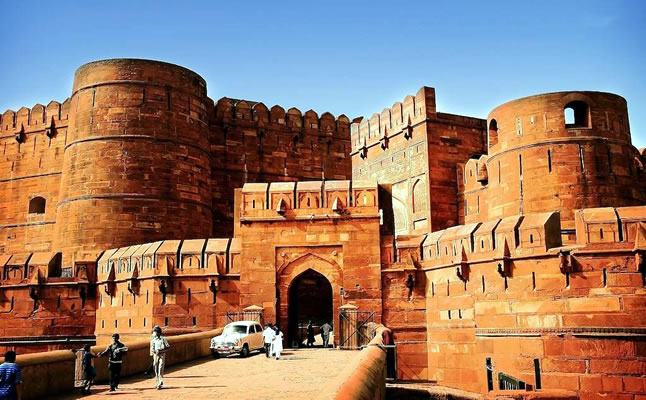Salawat Khan’s Tomb
(c. 1644-50 A.D.)
Hindi Version | View Gallery |
|
[Not a valid template]The tomb of Salabat Khan Mir-Bakhshi, popularly called ‘Chausath- Khambha’, is situated adjacent to the tomb of his father Sadiq Khan, on the Bye-pass road. He was Shah Jehan’s Mir-Bakhshi (Lord Treasurer) and held the mansab (rank) of 4000 zat (personal) and 2000 sawar (horsemen), and the title of ‘Salabat Khan’. He served the Emperor with total dedication. On 25 July, 1644, Rao Amar Singh Rathore, son of Raja Gaj Singh Rathore of Jodhpur and elder brother of Raja Jaswant Singh, affronted by some comment of the Mir-Bakshi, stabbed him to death by a dagger (katar) in the Diwan-i’Am in Agra Fort, in presence of the Emperor. Amar Singh was pursued and killed near the Akbar-Gate which the British later renamed Amar Singh Gate. Salabat Khan’s Tomb seems to have been build between 1644 and 1650 A.D. [Not a valid template]The tomb which is essentially a hall of 64 pillars of red stone stood on a platform of 5′ (1.52 m) height, approached by steps in the middle of each side, having a beautiful square Chhatri on each of its four corners. Each facade is made up of an arcade of five arches supported on twin columns on the outside in the middle, and four colums on the corners. Between each opposite pair of those openings are four internal ones with similar arches spanning 16 single pillars. Thus, there are 64 pillars altogether (Fig. 22), hence it popular nomenclature: ‘Chausath-Khambha’ or ‘the Hall of 64 pillars’. It is exactly like the ‘Chausath-Khambha’ of Delhi, being the tomb of Mirza ‘Aziz Koka which was built in c. 1624 A.D. [Not a valid template]The hall has, thus, been divided into 25 square bays and is open on all sides. The central bay is a little larger than others. It seems to have contained the cenotaph, and the real grave beneath it in the crypt which was originally accessible by a tunnel on each side. Originally, there was a chajja protecting the building externally on all sides; its brackets have survived. Probably, there was chhatris on its superstructure, one on each corner, harmoniously flanking the central barahdari (poen pavilion) which also does not exist. Only traces of the chhatris and the base of barahdari (which must have resembled the barahdari of the tomb of Etmad-ud-Daulah) have remained. A commenmorative building without a suitable superstructure was inconceivable in the age of Shahjehan (1628-58 A.D.). [Not a valid template]The square chhatri on each corner of the platform has engrailed (cusped) arches and a wide, projecting chhajja protecting them. Its dome rests on an octagonal drum and has the usual mahapadma and kalash-final. Internally, it is tastefully adorned with stalactite, arabesque and stylized floral designs painted on on polished stucco. The side faces of the plinth were once cased with beautifully panelled and carved stones. Each chhatri has a subterranean room beneath it. An opening concealed behind the steps on each side of the main platform is suggestive of a ventilating tunnel, leading to the underground crypt below the central compartment of the hall. [Not a valid template]Built entirely of red sandstone, the Chausath-Khambha spreads emphatically on the horizontal axis and seems to have been gorgeously set, originally, amidst a char-bagh (four-quartered) surrounded by such waterdevices as central canals, fountains, pahways, intermittent cascades with stairs on the sides and lily-ponds; without it, it looks barren and desolate. When complete with upper chhatris and barahdari on the superstructures of the main hall and a chhajja around it, with its beautiful surroundings, the building must have originally presented a very harmonious and rhythmic view. It belongs, essentially, to the age when total architectural effect was the primary concern of the builders and even with the limited resources at his disposal, he succeeded in his attempt to create a beautiful architecture. It is a pity that this once handsome tomb is now lying practically neglected, in a miserably ruinous condition. |




